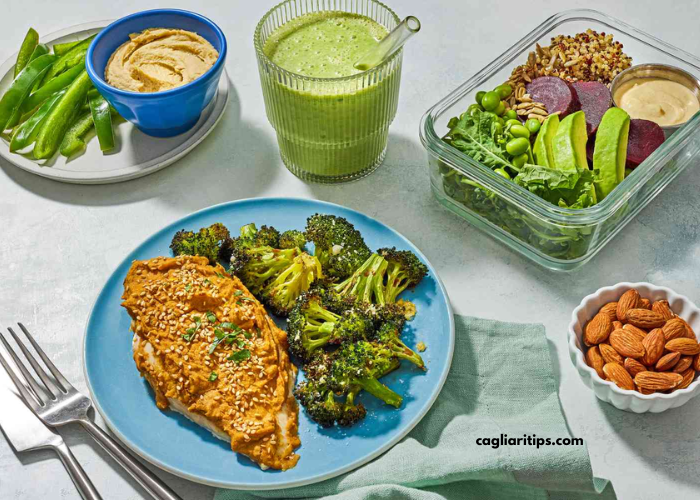Your Step-by-Step Healthy Eating Plan
Healthy eating is more than just a diet — it’s a lifestyle. Adopting nutritious habits can help improve your energy levels, mental clarity, physical performance, and even longevity. Whether you’re looking to lose weight, manage a health condition, or simply feel better each day, following a structured, sustainable healthy eating plan is key.
In this comprehensive guide, we’ll break down a step-by-step plan to help you eat better, feel stronger, and enjoy the benefits of a well-balanced life.
Why You Need a Healthy Eating Plan
Before diving into the steps, it’s essential to understand why a healthy eating plan is important. A balanced diet provides your body with the essential nutrients it needs — carbohydrates, proteins, fats, vitamins, and minerals — to function optimally. Here’s what a good diet can help you achieve:
-
Boost your immunity
-
Manage weight effectively
-
Reduce the risk of chronic diseases like diabetes, heart disease, and cancer
-
Improve mood and mental health
-
Enhance digestive health
-
Promote better sleep
By having a clear, personalized eating plan, you’re more likely to stick to healthy habits for the long term.
Step 1: Set Clear and Realistic Goals
Identify Your Motivation
The first step in any successful plan is setting SMART goals — Specific, Measurable, Achievable, Relevant, and Time-bound. Ask yourself:
-
Do I want to lose weight?
-
Am I trying to increase energy?
-
Do I want to manage a health condition?
-
Am I trying to build muscle?
Knowing your “why” will help you stay focused.
Avoid Unrealistic Expectations
Healthy eating is not about quick fixes. Avoid fad diets or extreme restrictions. Your goals should be sustainable and suited to your lifestyle and body type.
Step 2: Learn the Basics of Nutrition
Understand Macronutrients
-
Carbohydrates: Your body’s primary source of energy. Focus on whole grains, fruits, and vegetables.
-
Proteins: Essential for muscle repair and growth. Include lean meats, legumes, dairy, nuts, and seeds.
-
Fats: Crucial for brain function and hormone regulation. Opt for healthy fats like avocados, olive oil, and fatty fish.
Don’t Forget Micronutrients
Vitamins and minerals are vital for overall well-being. Incorporate a wide variety of colorful vegetables and fruits to ensure you get a mix of:
-
Vitamin A, C, D, and E
-
Calcium, Magnesium, Potassium, and Iron
Step 3: Create a Balanced Plate
Follow the MyPlate method or similar balanced eating models to build meals that meet your nutritional needs.
Portion Your Plate
-
½ Plate: Non-starchy vegetables (broccoli, spinach, peppers)
-
¼ Plate: Lean protein (chicken, tofu, beans)
-
¼ Plate: Whole grains or complex carbs (brown rice, quinoa)
-
Side: A serving of healthy fat (nuts, seeds, olive oil)
-
Drink: Water or an unsweetened beverage
This visual approach helps prevent overeating and ensures a well-rounded intake of nutrients.
Step 4: Stock Your Pantry and Fridge Smartly
Whole Foods First
Focus on buying minimally processed foods. Here’s a healthy grocery list to get started:
-
Proteins: Eggs, chicken breast, lentils, chickpeas
-
Grains: Oats, brown rice, quinoa, whole-grain pasta
-
Fruits & Vegetables: Apples, berries, spinach, kale, carrots
-
Healthy Fats: Olive oil, chia seeds, avocados, almonds
-
Dairy/Alternatives: Greek yogurt, almond milk, cheese (moderate portions)
Plan for Success
Always have healthy snacks on hand to avoid reaching for processed junk food. Consider:
-
Hummus with veggie sticks
-
Greek yogurt with berries
-
A handful of unsalted nuts
Step 5: Meal Prep and Planning
Why Meal Prep Works
Meal prepping saves time, reduces food waste, and minimizes the temptation of unhealthy choices during busy moments.
Simple Meal Prep Tips
-
Choose a day (e.g., Sunday) to prepare meals for the week
-
Cook in batches: grains, proteins, and chopped vegetables
-
Use portion-controlled containers
-
Rotate meals to avoid boredom
Sample Weekly Menu Idea
Monday:
-
Breakfast: Overnight oats with banana
-
Lunch: Grilled chicken quinoa bowl
-
Dinner: Lentil soup with whole-grain toast
Tuesday:
-
Breakfast: Smoothie with spinach, protein powder, and berries
-
Lunch: Turkey sandwich on whole grain bread
-
Dinner: Baked salmon, roasted veggies, and brown rice
Step 6: Mindful Eating
Slow Down and Savor
Mindful eating encourages being present while you eat. Avoid distractions like phones or TV during meals. This helps:
-
Improve digestion
-
Prevent overeating
-
Enhance enjoyment of food
Listen to Your Body
Learn the difference between hunger and cravings. Eat when you’re hungry and stop when you’re comfortably full.
Step 7: Stay Hydrated
The Importance of Water
Water plays a crucial role in:
-
Detoxification
-
Digestion
-
Metabolism
-
Skin health
How Much Should You Drink?
Aim for at least 8 glasses (2 liters) of water a day. Increase your intake if you’re active or live in a hot climate.
Pro Tip: Carry a reusable water bottle and sip throughout the day.
Step 8: Manage Cravings and Emotional Eating
Identify Triggers
Keep a food journal to track when and why you eat certain things. Emotional triggers like stress, boredom, or sadness can lead to unhealthy snacking.
Healthy Alternatives
Instead of processed snacks:
-
Go for a walk
-
Call a friend
-
Try deep breathing or meditation
-
Opt for a healthy snack if you’re genuinely hungry
Step 9: Practice Flexibility and Enjoy Occasional Treats
All Foods Fit
No food is inherently “bad.” It’s about balance and moderation. Enjoy your favorite treats without guilt — just not every day.
The 80/20 Rule
Follow healthy eating 80% of the time, and enjoy indulgences 20% of the time. This keeps you on track without feeling deprived.
Step 10: Evaluate, Adjust, and Stay Consistent
Regularly Assess Your Progress
Check in weekly or monthly:
-
Are you reaching your goals?
-
How do you feel physically and mentally?
-
Are you staying consistent?
Be Flexible with Your Plan
Life changes — and so will your needs. Adjust your eating plan accordingly. What works today may need tweaking next month.
Common Pitfalls to Avoid
Skipping Meals
Skipping meals can lead to:
-
Fatigue
-
Overeating later
-
Slowed metabolism
Aim for 3 balanced meals and 1–2 healthy snacks a day.
Over-Reliance on Supplements
Food should always be the primary source of nutrition. Use supplements only if recommended by a healthcare professional.
Not Reading Labels
Even “healthy-looking” foods can be packed with sugar, sodium, or unhealthy fats. Always check:
-
Serving size
-
Sugar content
-
Ingredient list
Final Thoughts: Make Healthy Eating a Lifestyle, Not a Diet
Healthy eating isn’t about strict limitations. It’s about feeling great, having more energy, improving your health, and boosting your mood. A step-by-step plan helps you form long-term habits, rather than temporary diets that are hard to maintain.
Remember, it’s okay to start small. Even small changes — like drinking more water or adding veggies to every meal — can lead to significant improvements over time.
Bonus Tips to Enhance Your Healthy Eating Plan
Get Enough Sleep
Sleep affects hunger hormones and cravings. Aim for 7–9 hours of quality sleep per night.
Incorporate Regular Exercise
Movement supports metabolism, digestion, and overall health. Aim for at least 150 minutes of moderate activity per week.
Build a Support System
Surround yourself with supportive friends, family, or join a healthy eating group. Accountability boosts success.
Frequently Asked Questions (FAQs)
What is the best diet for long-term health?
There’s no one-size-fits-all approach, but generally, the Mediterranean diet, plant-based diets, and whole-food-focused plans are considered among the healthiest.
Can I lose weight without giving up my favorite foods?
Yes. Incorporating your favorite foods in moderation, alongside nutrient-dense meals, is sustainable and prevents binge eating.
How do I stick to my healthy eating plan when eating out?
Choose grilled over fried, ask for dressings on the side, and control portions. Don’t be afraid to customize your order.
Conclusion
Adopting a step-by-step healthy eating plan doesn’t have to be overwhelming. With the right strategy, you can make lasting changes that not only transform your body but also uplift your mind and lifestyle. Start small, stay consistent, and focus on progress — not perfection.
Remember: Healthy eating is a journey, not a destination.



